St. Stephen's United
Church of Christ
St. Stephens Church today is located at Sixth
and Arch Streets (110 N. Sixth street) in Perkasie, PA. The name
of the church comes from St. Stephen, who was known for being
the first Christian martyr.
EARLY CHURCH HISTORY
The church dates back to 1883 when a group
of people organized a Reformed Church. Services were conducted
in the school house on Main Street (now 509 Chestnut Street) with
ministers from area churches.
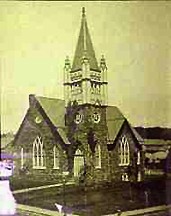 |
|
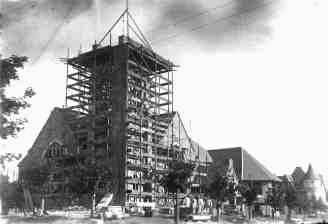 |
| On April 24, 1885 the cornerstone was laid
by a small group hoping to form a Reformed Church. An edifice was made
along with a parsonage in 1902. This building was eventually rebuilt with
another tower and larger worship area. |
|
Here is St . Stephen's Church (the second church)
during reconstruction in 1904. Note the extensive scaffolding used to
construct the bell tower. |
BUILDING and CHANGES TO THE STRUCTURE
The building of the first church was contracted
to Jonathon Wolfe of Telford; the drawings and specifications
were furnished by Benjamin D. Price, architect of Philadelphia,
PA. The structure seated 500 people and had a basement for Sunday
School and other church meetings. The building was constructed
in the Gothic style with large stained glass windows, bell tower
and steeple. Walls were constructed of native stone and black
mortar. The first parsonage was built on Arch Street, NW of the
original church.
On April 24, 1885 the cornerstone was laid
for the first church with the dedication of the church on November
1886. In 1902 a new structure and parsonage were built on the
site and the congregation worshiped in the Opera House (Fourth
& Walnut Streets).
On May 1, 1904 a new church was dedicated on
the site. The church was built of Rockhill granite and was built
exactly like the first church inside - only larger. The main church
seated 450 and the Sunday school room, which opens to the main
auditorium seated 350 people - for a total seating capacity of
800. The cost of the new structure was $25,000 and was built by
David W. Stoneback of Perkasie. In 1904 plans were made to light
the church with 183 electrical lights. The 2000 pound Meneely
bell was also installed in 1904
In 1924 the interior was renovated including
new electrical fixtures and re-frescoing. In 1926 there was a
dedication of a new pneumatic pipe organ with chimes, harp, and
antiphonal organ. In October of 1928 a new 410 foot stone wall
was completed on the east side (Sixth Street side) of the church
property.
The 1904 church tower was completely renovated
in 1998. New mortar, wood, tin, trim, and roofing was included.
Tower gargoyles were removed and restored.
On May 28, 1989 ground was broken for renovations
that were completed in August 1990. These recent additions cost
$1,000,000 and included new parking entrance with overhang, conference
room, new kitchen, and upper Sunday School room (next to the kitchen).
 |
|
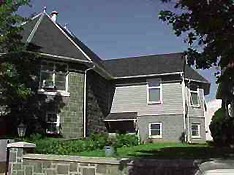 |
| Here is the church as it appears
today at Sixth and Arch Streets. ornamental pear trees were recently added
along the road side on both Sixth and Arch Streets. |
|
One of the additions to the building
as viewed from Sixth street. |
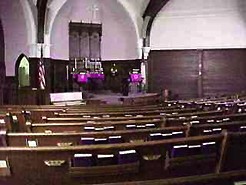 |
|
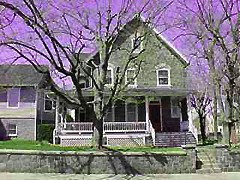 |
| Here is the interior of the church where worship
takes place today. Note the arched design of the pews and vaulted ceiling
elements. |
|
A parsonage on the Sixth Street side of the
church was built in 1903. |
GOTHIC STYLE
This church like many in the Upper Bucks County
area features a gothic revival architectural style. Major elements
on the exterior of the building that help characterize this building
as Gothic style include pointed arches above doors and windows,
pointed towers and design elements, gargoyles, stained glass,
and heavy window tracery.
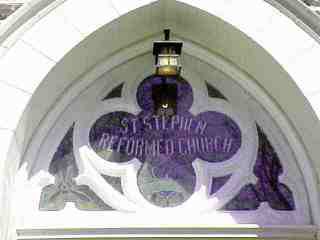 |
|
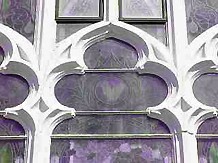 |
| "St. Stephens" in stained glass is
placed above the door. This window is a quartrefoil (four leafed) design. |
|
Heavy tracery, or curved ornamental stone framed
windows are found throughout the exterior of the main building. |
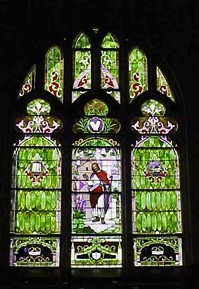 |
|
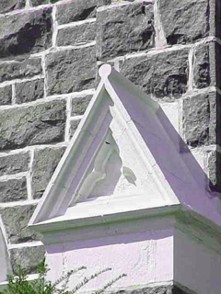 |
| Colorful stained glass windows are outlined
with heavy tracery as seen from the inside of the building. Note the pointed
arches within the larger pointed arch. |
|
Numerous details in the Gothic style
point upward with fine ornamentation. |
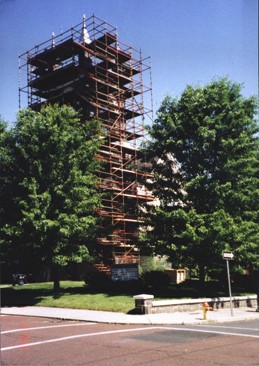 Tower Repairs in 1998
Tower Repairs in 1998


